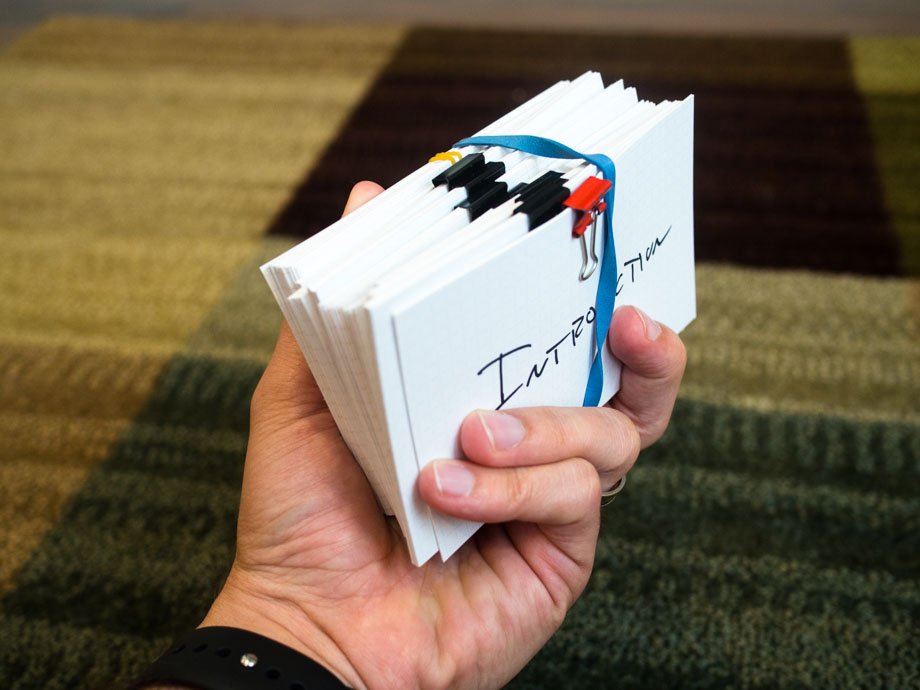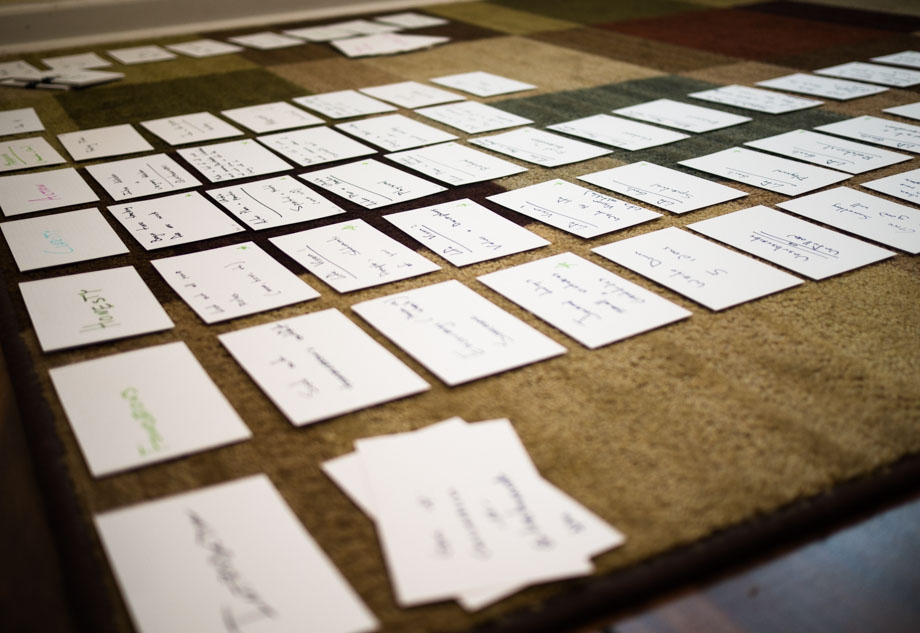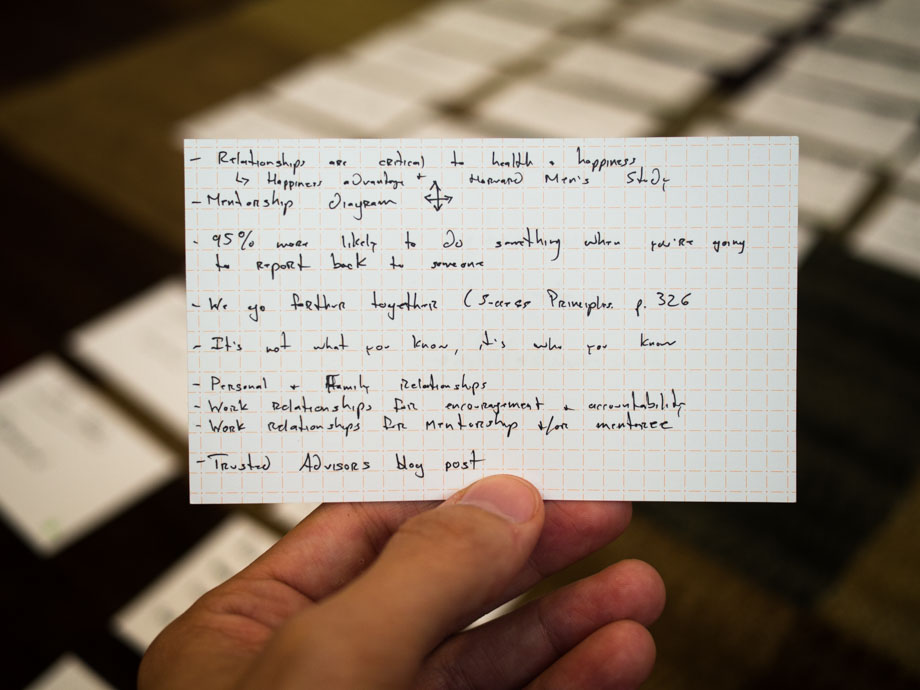As you know, I’ve been working for myself from home for over four years. And even still, I’m terrible at estimating how much time I need to spend on a particular task.
At first, my bad time estimations would frustrate my wife. She’d ask me how long until I was done working and I’d think about how I had just three more emails left in my inbox and how I could probably get them triaged in 5 minutes. But then an hour would go by…
Fortunately my wife has learned to take my time estimations and quadruple them. Because I still frequently overestimate what I can get done in a short amount of time. And, like many others, I also tend to underestimate what I can accomplish over an extended season.
It’s a backwards problem. Not only does it put all the emphasis on “how much” I can do today — it also means I get frustrated when I can’t get everything done that’s on my massive, never-ending, to-do list.
When my emphasis is on today’s quantity of tasks accomplished, it leads me to de-value the little actions that have great impact over time. The little things that ultimately lead to incremental yet consistent progress and thus accomplishing a lot over an extended season.
If you know anything about investing you know it’s far better to invest $100 every month for 30 years then to invest $36,000 all at once three decades from now.
Assuming an 8% rate of return, if you invested a mere $100/month for 30 years then your investment would be worth $135,939.
However, if you waited until the very end of those 30 years and then tried to invest all $36,000 at once then your investment would be worth exactly that: $36,000. You’d miss out on $100,000 worth of compounding interest. Not to mention the fact that it’s a lot harder to come up with $36,000 all at once than it is to come up with $100 consistently.
This principle is true for all the investments of our lives. It extends far beyond just finances. It’s true for our relationships, our vocation and our career, our art, our education, even our physical health.
Doing a little bit on a regular basis is far more powerful than doing a whole lot at once. It’s also far more sustainable.
But we despise doing a little bit on a regular basis. We live in a culture that craves microwave results. And thus, we have acquired a thirst for instant gratification.
For example, we want to get healthier, but the idea of starting a routine of walking for just 15 minutes a day doesn’t motivate us — we despise how simple and humble that approach is. And so instead we buy a gym membership, hire a personal trainer, spend $500 on new workout clothes and fancy armbands to hold our iPhones, and we commit to 2 hours a day 6 days a week. Then we burn out in a few weeks time never to exercise again.
Only a fool would deposit $100 into a savings account and come back the next day expecting it to have grown to $200. It’s not until years later that the account begins to see the exponential return on the investment. We know that financial investments and the growth of compound interest takes time — so too the investments we make in the rest of our lives.
One of the personal challenges of doing small things consistently over time is that we don’t naturally choose them. In the moment, we would rather spend that $100 on a new toy or a nice dinner instead of investing it.
We tell ourselves that it’s only $100, and that spending it instead of investing it just this one time doesn’t really hurt anything. But it does hurt. And the reason it hurts is because it makes spending the $100 next time all the easier. And before long, it’s been a decade and we’ve yet to invest a dime.
Clearly, there is value in small things done consistently over time.
Which means that our most basic actions and seemingly inconsequential routines are actually the key players moving our life in whatever direction it is going.
Ben Franklin said, “Human felicity is produced not as much by great pieces of good fortune that seldom happen as by little advantages that occur every day.”
What are these little advantages that occur every day?
They are the daily habits and lifestyle choices we make.
For a while we have choose them — sometimes on purpose and sometimes not. But then, after a few weeks or a few months they begin to choose us back. And over time, they become deeply rooted. We just do them.
This is great news for our good habits! It means that if we begin to implement something healthy and helpful into our lifestyle, then over time it will become second nature to us.
But our deep-rooted routines can be a nightmare if they are things we don’t want to be doing. Such as a poor diet, unhealthy relationship with our spouse or loved ones, inability to manage money, etc.
We don’t all have the physical and mental willpower to make great decisions all day every day. In fact, as the day goes along, we slowly lose our willpower.
When I was in high school, after classes my friends and I would walk back to my house and we’d just sit around doing nothing.
One person would ask: “So, what do you guys want to do?” And someone else would respond: “I don’t know. What do you want to do?”
None of us could think of any ideas for what to do. Nor could any of us make a decision. It’s not just that we were teenage dudes — we were also mentally tired from a full day of school.
Even now, 15 years later, when my work day is done, I just want to collapse on the couch and not make any decisions or think about anything.
When you’re in this tired state is the moment when your lifestyle habits take over. Whatever your default actions, behaviors, and decisions are, these are the things you will do when you are low on willpower and your decision-making ability is fatigued.
I think this is a huge reason why the average American spends 5 hours or more watching television every day.
He or she comes home from the day feeling tired and doesn’t want to think about what to do. So he or she simply turns on the television and pretty soon the whole evening has been spent watching sitcoms and crime dramas.
Over time (which can be as quickly as a few weeks for some, but takes about 8 weeks for most) the act of watching TV every night after work becomes a routine. It turns into a lifestyle habit. That person’s mind and body expect to watch TV and even look forward to it. It’s a habit — a reflex.
Now, I’m not here to preach that 5 hours of TV every day is bad (you can figure that one out for yourself).
You can do whatever you want with your time. But… if you were to choose how you would prefer to spend your week which one of these options would you pick?
- Watch 35 hours of television.
- Write 7,000 words toward your next book.
- Encourage 7 of your closest friends and family members.
- Read 7 chapters of a book.
- Walk 7 miles.
I know some of you will say that watching 35 hours of TV per week is your preferred way to spend your time. But I bet most of you would choose to write, read, connect with others, or stay healthy.
Now, what if I told you that you could trade the 35 hours of television for the other 4 tasks combined?
35 hours of TV is equal to 5 hours every day for 7 days.
With those same 5 hours each day, you’d have time to spend one whole hour writing, one whole hour encouraging someone over email or making a phone call, one whole hour to read a chapter from a book, one whole hour to walk a mile around your neighborhood, and still have one whole hour to spare (heck you could use that last hour to watch an episode of your favorite show).
You can do a lot in 5 hours. Especially if you break it up into small routines.
It sounds ridiculous that someone could get so much done every day when they’re so used to getting nothing done. But it’s not ridiculous. It just requires building better defaults.
If you choose something long enough, eventually it will choose you back. The same way your mind and your body looked forward to turning on the TV when you got home from work, so too will your mind and body learn to look forward to reading, writing, walking, and encouraging others.
Leo Babauta wrote about how his most important things (writing, meditation, reading, email processing, workouts, meals) he doesn’t even have to think about. He’s built them into his day as defaults.
I cannot stress enough the importance of having your most important work be a part of your daily routine.
There are two quotes that I use often throughout The Focus Course:
“People do not decide their futures, they decide their habits and their habits decide their futures.”
— F.M. Alexander
“You will never change your life until you change something you do daily. The secret of your success is found in your daily routine.”
— John C. Maxwell
By far and away, if you have more ideas than time but more time than attention, the best way to keep the needle moving forward is to have smarter “defaults” for how your spend your time and energy. Keep choosing the right actions and attitudes until they choose you back.





